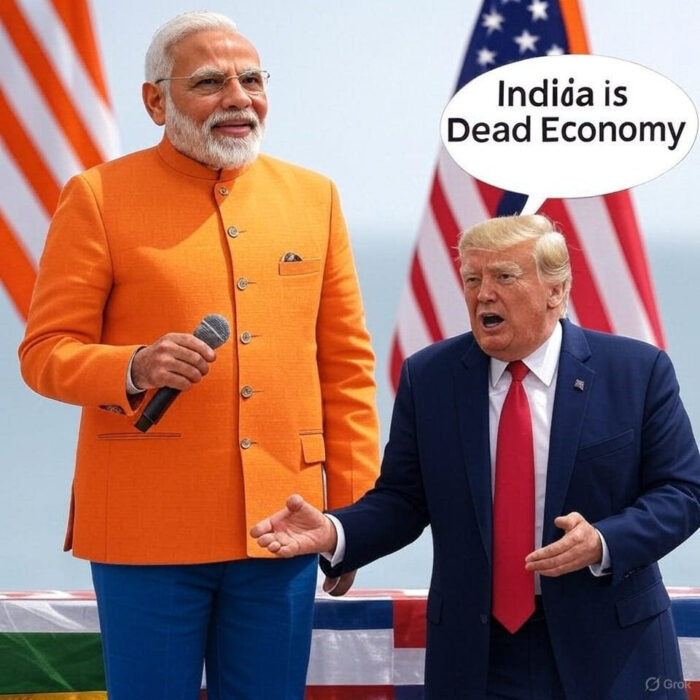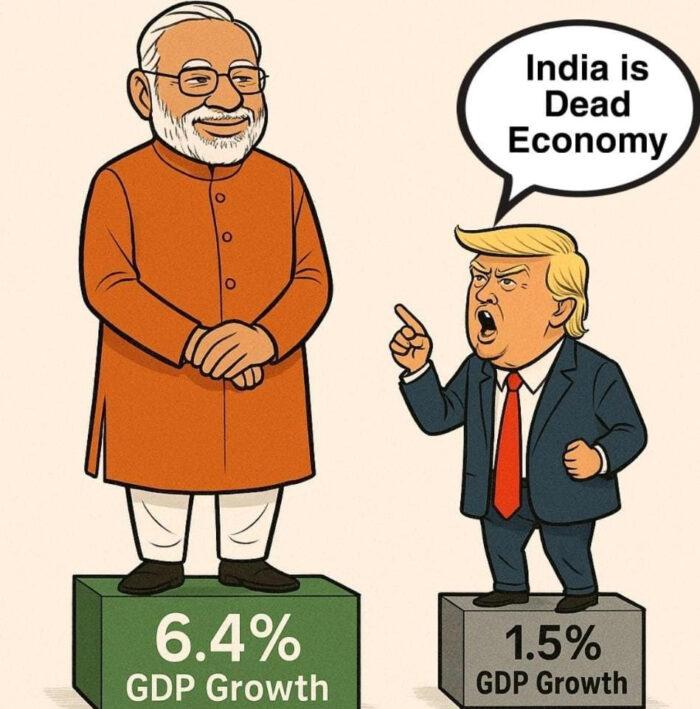 President Donald Trump has again taken to social media—this time branding India a “dead economy,” pairing it with Russia, and doing so barely days after declaring that Washington will impose 25 percent tariffs and additional penalties on New Delhi’s purchases of Russian oil, effective 1 August. The outburst came within hours of his headline-grabbing energy pact with Pakistan and reprises an old habit: boasting—more than two dozen times—of his alleged role in securing the “Operation Sindoor” cease-fire, even though Prime Minister Narendra Modi has, on the floor of Parliament, categorically ruled out third-party mediation. Far from an economic verdict, this latest condemnable slur is best read as frustrated brinkmanship—an attempt to browbeat Indian negotiators and cow a prime minister who is made of sterner stuff and will not yield to empty threats.
President Donald Trump has again taken to social media—this time branding India a “dead economy,” pairing it with Russia, and doing so barely days after declaring that Washington will impose 25 percent tariffs and additional penalties on New Delhi’s purchases of Russian oil, effective 1 August. The outburst came within hours of his headline-grabbing energy pact with Pakistan and reprises an old habit: boasting—more than two dozen times—of his alleged role in securing the “Operation Sindoor” cease-fire, even though Prime Minister Narendra Modi has, on the floor of Parliament, categorically ruled out third-party mediation. Far from an economic verdict, this latest condemnable slur is best read as frustrated brinkmanship—an attempt to browbeat Indian negotiators and cow a prime minister who is made of sterner stuff and will not yield to empty threats.
India—Anything but “Dead”
India is the world’s fourth-largest economy, inching towards being the third largest, and the fastest-growing in the G-20. Its equity markets attract record foreign inflows; its start-up ecosystem has minted more than a hundred unicorns; and its macro fundamentals—manageable debt ratios, robust forex reserves, and a burgeoning manufacturing base—draw praise from every major multilateral agency. A “dead” economy does not power global IT services, sustain the planet’s third-largest consumer market, or anchor critical supply-chain diversification.
Trade Reality: A Two-Way Street, Not a One-Way Barrier
Trump’s grievance over high Indian tariffs ignores the broader picture. India exports roughly US $90 billion in goods and services to the United States each year—pharmaceuticals, refined petroleum, IT services, diamonds—while American firms ship about US $64 billion in aircraft, LNG, crude oil, medical devices, cotton, and advanced software to India, and hold more than US $60 billion in cumulative FDI. Bilateral trade has risen steadily despite episodic tariff skirmishes, belying the claim that commerce lies dormant.
The Pakistan Pivot and Why It Rankles
Trump’s decision to champion an oil-and-gas partnership with Pakistan—and tout the possibility of selling that energy to India—has added spice to his tariff rhetoric. His latest broadside arrives just days after the deal’s unveiling, underscoring irritation that New Delhi will not sign on without extracting reciprocal gains. Throwing in boasts about “Operation Sindoor” only highlights how detached his talking points are from India’s own diplomatic red lines.
Strategic Autonomy Is Not Defiance
From defence co-production to Quad naval drills, India works closely with Washington where interests align. Yet it also buys S-400 systems from Russia, diversifies energy imports, and champions a multipolar Asia. That posture—independent, not antagonistic—sits uneasily with a President who prizes transactional obedience. Under Prime Minister Modi, India has made it clear that partnership does not entail subordination, and no amount of bluster will change that calculus.
Why Modi’s Government Holds the Upper Hand
Market Leverage: A 1.4-billion-strong consumer base gives India powerful negotiating clout; global majors queue up for access even when tariffs pinch.
Defence Convergence: India conducts more military exercises with the United States than with any other partner, while co-developing drones, artillery, and jet-engine technology.
Geo-economic Centrality: From critical-minerals supply chains to semiconductor packaging, India is pivotal to U.S. efforts to recalibrate away from China.
Trump can thunder about tariffs, mediation, or “dead economies,” but Washington’s Indo-Pacific strategy still requires an economically vigorous, strategically autonomous India.
Looking Ahead: Assert Interests, Ignore the Noise
India will continue to chart its own course—balancing Russian energy deals, deepening technology and security cooperation with America, and trimming tariffs where domestic priorities allow. Even as it continues trade negotiations with the United States in good faith, led by its competent Commerce Minister Piyush Goyal, New Delhi must also prepare calibrated counter-measures should 1 August tariffs bite: diversifying export destinations, accelerating supply-chain incentives for U.S. firms on Indian soil, and leveraging multilateral forums to press its case.
Above all, India need not dignify a bully’s jibes by similarly worded response. The numbers, investment flows, and global investor confidence already refute the “dead economy” label. Prime Minister Modi’s government, un-intimidated by brinkmanship, should stay focused on growth, nurture partnerships based on mutual respect, and remind friends and critics alike that India’s sovereign decisions—on cease-fires, on oil, on trade—are made in New Delhi, not dictated from anyone’s social-media feed.
 Author credentials:
Author credentials:
Karan Bir Singh Sidhu, IAS (Retd.), former Special Chief Secretary, Punjab, and MA (Economics), University of Manchester, writes at the intersection of geopolitics, Trump’s tariff tactics, and India’s emergence as a sovereign power in the comity of nations.